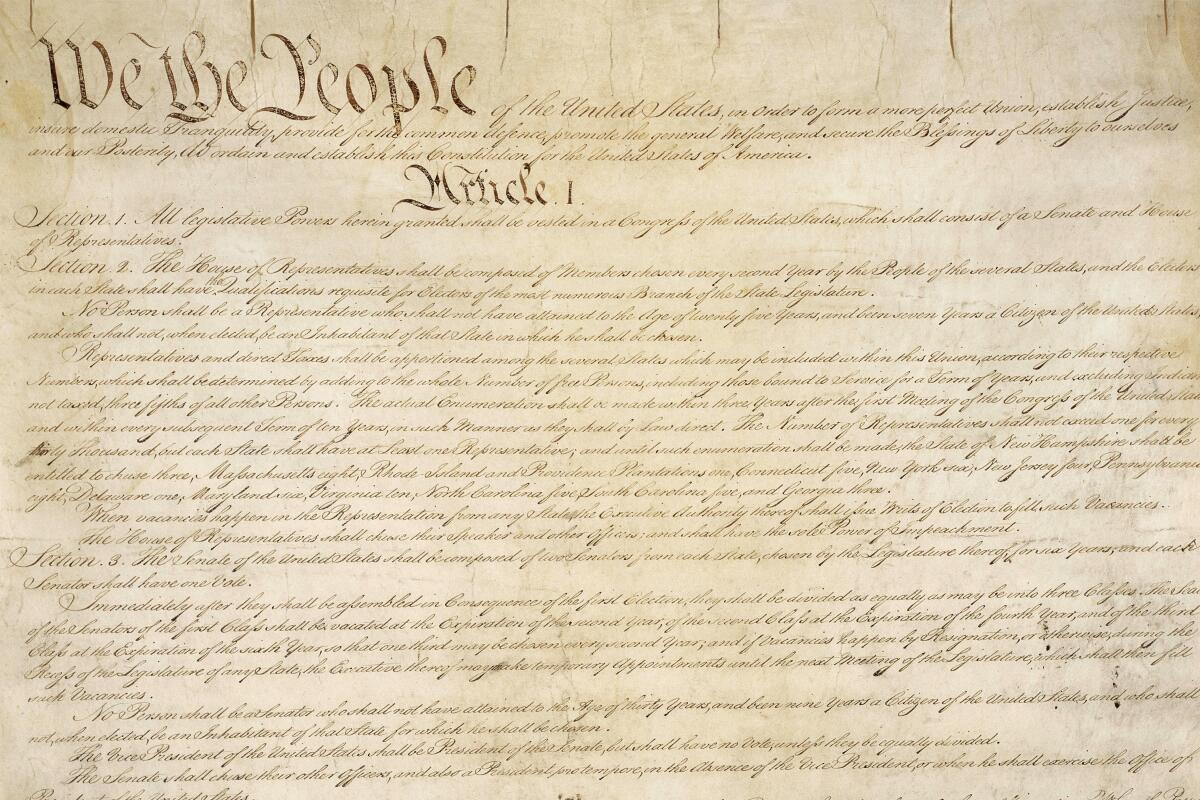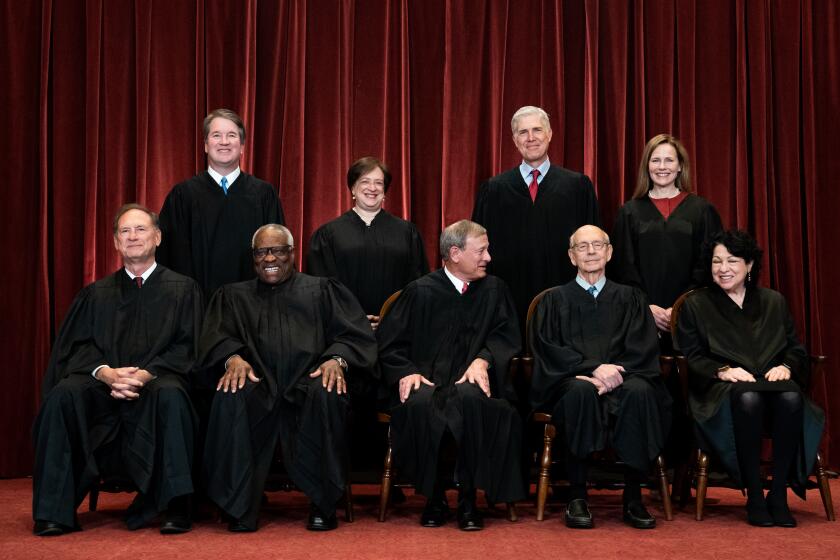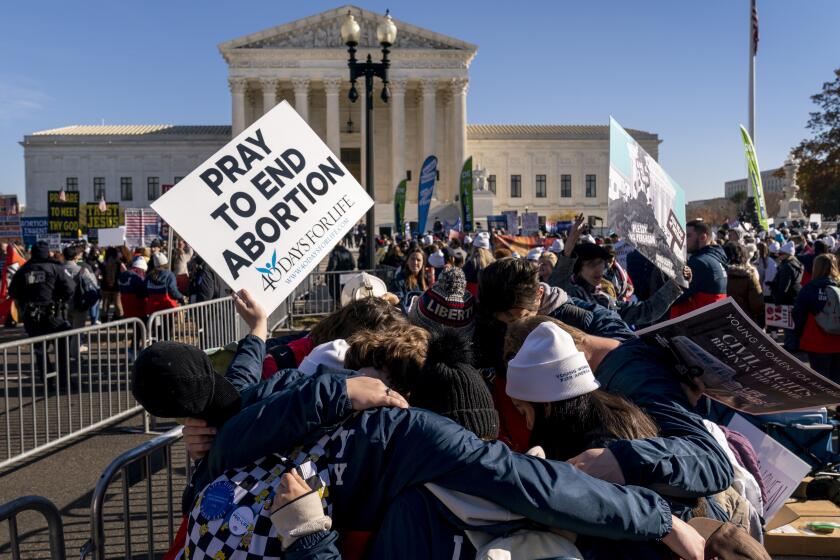Column: Hate the Supreme Court? Our problems actually start with the Constitution

- Share via
So you’re unhappy with the Supreme Court justices who turned back the clock on environmental protection, abortion, school prayer and guns? You’re angry because they’re ideologues with a reactionary agenda, flexing their muscles to eliminate rights, weaken government and endanger the planet?
Me too. They’re reprehensible.
But let’s be honest: The problem isn’t just with the justices. The problem, or at least a substantial portion of it, lies with the U.S. Constitution itself.
Yes, the hallowed Constitution, the document hammered out in 1787 by 55 bewigged men in Philadelphia. Our revered charter that lays out the foundational rules and principles at the heart of the American experiment: freedom of speech and religion, the separation of powers, federalism, bicameralism and all the other checks, balances, rights, promises and innovations that make this nation what it is.
Opinion Columnist
Nicholas Goldberg
Nicholas Goldberg served 11 years as editor of the editorial page and is a former editor of the Op-Ed page and Sunday Opinion section.
These days the Constitution is showing its age.
“It was written by a small group of white male landowners clustered along the Eastern Seaboard in a largely agrarian society in the late 1700s,” said David S. Law, a professor at the University of Virginia School of Law who studies courts and constitutions around the world. “How could it possibly fit the needs of a highly diverse country of 300-plus-million people in the 21st century, a military and economic superpower in a globalized world, a highly developed, post-industrial nation that stretches from sea to shining sea?”
In its defense, the 235-year-old Constitution has been extraordinarily resilient. It is the oldest constitution still in force in the world. Many young nations have used it as a model or inspiration, beginning with France, whose revolution came just a few years after ours. Nations emerging from colonialism in the 20th century used it as well.
But today it is too inflexible, insufficiently democratic, and even in some ways dysfunctional. Many look to it now less as a model to be emulated than as a example of what to avoid.
Here are some of the criticisms.
The Constitution created the undemocratic U.S. Senate that allots the same representation — two senators — to a state like Wyoming, which has fewer than 600,000 people, as it does to California, with nearly 40 million people.
It established the voting system that allows presidents to be elected who did not win the popular vote.
The Supreme Court’s most liberal justice says the court’s most conservative justice is kind and thoughtful and a friend. Progressive Twitter is highly unimpressed.
It’s got antiquated — and dangerous — provisions, such as the anachronistic “right to bear arms,” which reflects long-forgotten concerns dating to post-revolutionary America. Today, no countries protect gun rights in their constitution except the United States, Guatemala and Mexico.
What’s more, constitutional thinking has evolved since 1787. Today, most new constitutions include far more enumerated rights than ours, notes David Law. The right to education, for instance, and to privacy, food, healthcare and housing. Many modern constitutions protect reproductive rights, freedom of movement, the right to unionize and the rights of the disabled.
Today, more than 100 national constitutions include explicit references to environmental rights.
The rights of women are singled out for protection in 90% of today’s constitutions.
These kinds of rights, unmentioned in our Constitution, reflect 21st century issues. No one is concerned today about the quartering of troops or the establishment of well-regulated militias.
Compared with a contemporary constitution, ours is short and vaguely worded. “That’s why we have huge debates over interpretive theories,” says Mila Versteeg, who is also a law professor at the University of Virginia. “Because the Constitution’s text gives so little guidance.”
The Constitution’s lack of specificity leaves much to the interpretation of the Supreme Court, granting tremendous power to that group of nine unelected justices. (Especially since the Constitution also grants them life tenure.)
Got a precedent you don’t like? Now’s your chance to have it struck down by a newly aggressive conservative court.
That system might work reasonably well if the justices interpreted broad principles with an eye to the present and the future, allowing for constitutional adaptation and flexibility.
But these days the court is in the hands of a group of archconservatives and so-called originalists who believe in sticking narrowly to the Constitution’s text and, where interpretation is necessary, relying on what they discern the framers believed in 1787.
That just makes our Constitution seem all the more out-of-date.
Of course, if we feel trapped by an archaic constitution, there’s a mechanism for revising it: It can be amended.
So by all means let’s do that, right? Let’s ban corporate money from politics! Protect gay, transgender and women’s rights! Fix the Senate!
Most nations replace their constitutions every 19 years on average. Thomas Jefferson believed a new constitution should be written by each new generation.
Unfortunately, amending the U.S. Constitution is extraordinarily difficult; it requires a vote of two-thirds of both houses of Congress and, after that, ratification by three-quarters of the states. A double supermajority.
The Constitution may be the biggest obstacle to meaningful gun control, and in this environment, amending the Constitution is virtually impossible.
That’s why it has been amended only once in the last 50 years.
And political polarization makes amending it even harder.
Now I don’t mean to suggest that the Constitution needs to be replaced or even drastically rewritten. It has many strengths, and there are advantages to a battle-tested system. Besides, we don’t want it to overpromise; some countries (North Korea, for example) guarantee rights they then fail to protect.
Furthermore, opening up the Constitution to dramatic revision could also lead to undesirable changes. A constitutional convention, currently supported by many on the Republican right, would come with grave risks.
But we’ll never solve our problems without, at the least, a frank, no-sacred-cows discussion of what works and what doesn’t.
It is no knock on the framers to acknowledge that they didn’t produce a document that fully addresses our 21st century problems. How could Benjamin Franklin, James Madison or John Jay have anticipated TikTok or GPS or pilotless drones or rapid-fire assault rifles or school shootings?
They couldn’t have. But it is hardly unreasonable for us to want a constitution that addresses the issues that concern us today, not those that faced a new republic in the long-ago past.
More to Read
A cure for the common opinion
Get thought-provoking perspectives with our weekly newsletter.
You may occasionally receive promotional content from the Los Angeles Times.















